On this page we’ll take a look at the best jazz guitars. First we’ll discuss the pros and cons of various types of jazz guitar. We’ll then take a look at some of the very best jazz guitars of past and present.
The Best Jazz Guitars: Page Index
- What is the best type of guitar for jazz?
- A list of the best jazz guitars of past and present
- Ibanez AF200
- Heritage Eagle Classic
- Gibson ES-175
- Gibson ES-275 Thinline
- Gibson ES-330
- Gibson ES-335
- Gibson ES-5
- D’Angelico Excel
- Ibanez GB10 George Benson
- Ibanez JSM100 John Scofield
- Gibson L-4 CES
- Gibson L-5 CES
- Gibson Les Paul
- Peerless Maestro Martin Taylor
- Benedetto Manhattan
- Selmer / Maccaferri Modèle Jazz
- Godin Montreal Premiere
- Yamaha SA2200
- Gibson Super 400
- Fender Telecaster
- Guild X-175 Manhattan
More Jazz Guitar Articles On Guitar Command
What Type of Guitar Is Best For Jazz?
Any type of guitar can be used to play jazz. Classical guitars, acoustic guitars, solid-bodied electric guitars and semi-acoustic / semi-hollow guitars; all can be – and have been – used by jazz guitarists.
With that being said, every type of guitar has its advantages and disadvantages for playing jazz. In this section we’ll go through the main types of jazz guitar and weigh up their pros and cons.
Semi-Acoustic Guitars For Jazz
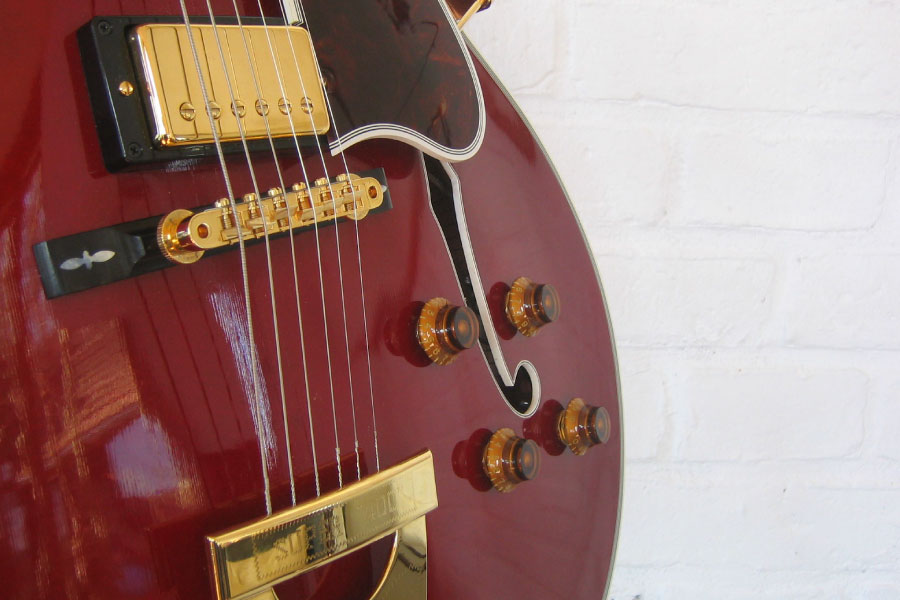
Semi-acoustic guitars are also known as hollow-body guitars (or just ‘semi’s’). They’re essentially electric guitars with hollow or partially-hollow bodies.
Although most semi-acoustic guitars aren’t designed to be played acoustically (i.e. without an amplifier), their hollow bodies provide improved resonance and a richer, fuller tone compared to their solid-body counterparts. This makes them ideal for jazz.
Semi-acoustic guitars are the standard, go-to guitars for jazz. This particularly applies to large, wide-bodied guitars known as ‘archtops’ on account of their curved tops. Archtops such as Gibson’s ES-175 and Super 400 are the archetypal (no pun intended) jazz guitars.
Most semi-acoustic guitars are fitted with humbucking pickups, which produce a more powerful, richer tone than their single coil counterparts.
Guitars used for playing jazz are often strung with heavy gauge, round-wound strings for that authentic sound and feel.
Archtop Jazz Guitars
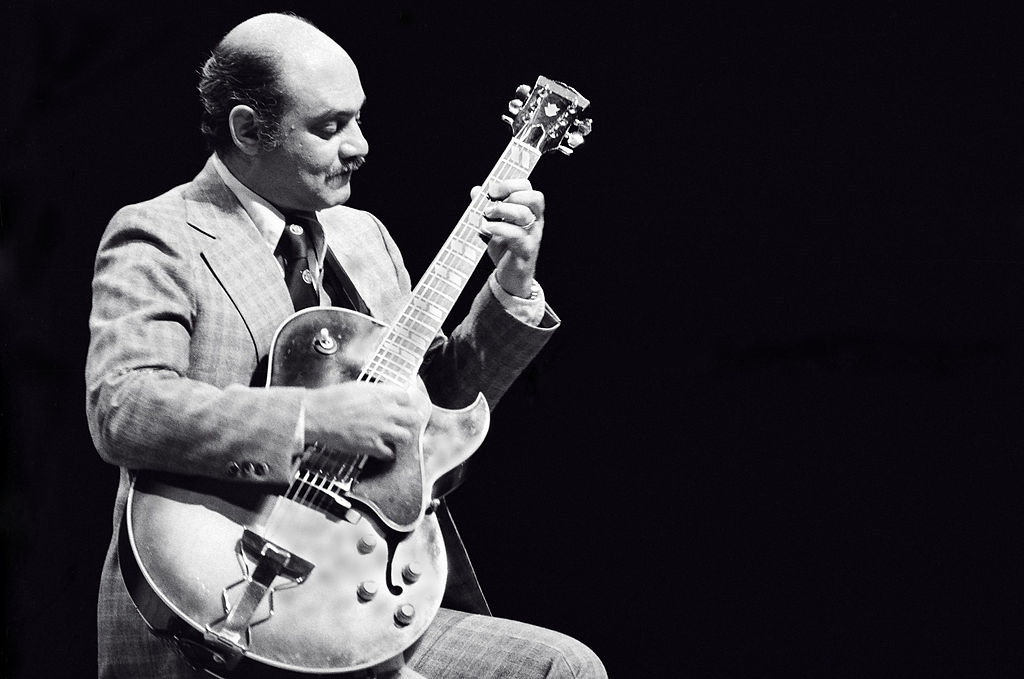
Pros
- The archetypical jazz guitars
- Classic rich jazz guitar tone
- Good looking!
- Hold their value (and may increase in value)
Cons
- Expensive (often extremely)
- Large and unwieldy
- Prone to feedback
- Not ideal for other styles of music
Archtop guitars are without doubt the type of guitar most commonly associated with jazz. These big, hollow-bodied guitars have characteristic curved – or ‘arched’ fronts (and often backs). Archtop guitars are sometimes called ‘jazz boxes’.
The archtop is the most common type of guitar on the list of best jazz guitars further down the page.
Most archtops have f-holes instead of a central sound hole, reflecting the influence of the violin family of instruments on their original design.
Archtops usually have fully-hollow bodies, with no feedback-reducing center block such as that found in semi-hollow guitars such as the Gibson ES-335. The lack of a center block gives them a more natural acoustic sound, but makes them prone to feedback when amplified at high volume.
Because the majority of jazz guitarists use only the warmer neck pickup, several archtops lack the more trebly bridge pickup.
The arched front of an archtop guitar is formed in one of two ways; the most time-intensive (and therefore most expensive) way is to carve the curve from a solid piece of wood. Alternatively, a laminated sheet can be heat-pressed into the required shape.
However they’re constructed, archtop guitars are usually more expensive then semi-acoustic and solid bodied guitars – often significantly so.
The flip side of this is that archtop guitars do tend to hold their value better than other types of guitar. If you buy a good quality second-hand archtop then there’s a good chance that you’ll be able to sell it for the same price – if not more – a few years down the line.
In general, archtop guitars are the best guitars for jazz, but can be slightly limited for other styles of music*. Their tone is thick and woody, they’re large and cumbersome to hold, relatively fragile, and their hollow design is prone to feedback.
As a result, if you want to play other styles of music as well as playing jazz, then you may be better off getting a standard semi-acoustic or a solid-body guitar.
* Of course, there are exceptions – guitarists such as Steve Howe use archtops for rock and other styles of music.
Non-Archtop Semi-acoustic Guitars For Jazz
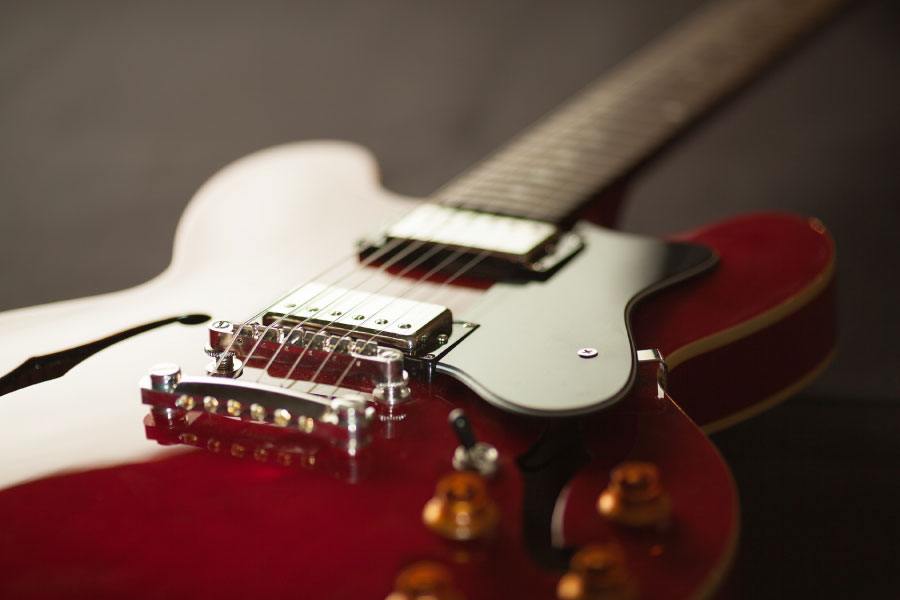
Pros
- Usually cheaper than archtops
- More versatile than archtops
- Less prone to feedback than archtops (see cons)
Cons
- Jazz tone not quite as authentic as that produced by an archtop
- More prone to feedback than a solid-body guitar (depending on construction)
Semi-acoustic guitars typically have a warmer, more expressive tone than their solid-bodied counterparts. Many fusion guitarists use semi-acoustic guitars rather than full-on jazz boxes due to this type of guitar’s additional flexibility and lack of feedback problems.
Solid-Bodied Guitars For Jazz

Can you play jazz with a solid body guitar? Of course, but for some it may be a compromise too far.
With the neck pickup selected and the tone control dialed down, a solid body guitar can produce a passable jazz tone. It won’t be quite as ‘bell-like’, and perhaps a little ‘thinner’, that that of an archtop, but it will be perfectly adequate, and you could – as other solid-body jazz guitarists have done – make it ‘your sound’.
The strength of a solid-body guitar for jazz is its versatility; with a solid body you can play a jazz gig one night and a rock gig the next.
Although solid bodied guitars aren’t typically thought of as jazz guitars that hasn’t stopped them from being used by many great jazz guitarists.
Pros
- No feedback issues in normal use
- Usually less expensive than a semi-acoustic
- More versatile than a semi-acoustic, especially an archtop
- More tolerant to being dropped or knocked than a semi acoustic
Cons
- Won’t produce a totally authentic jazz tone.
- Aficionados may turn their noses up at solid body guitars
- Turning up at a jazz session with an Ibanez Gem may raise a few eyebrows!
Acoustic Guitars For Jazz
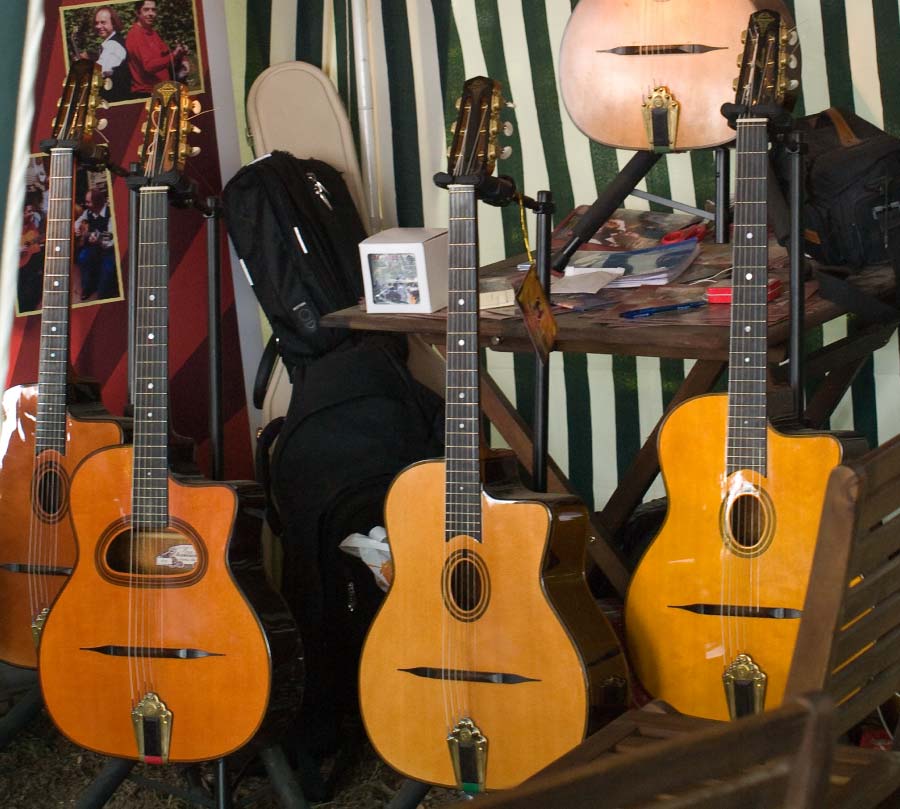
Pros
- No amplifier needed
- Pleasing, expressive lead sound
- Quiet unless amplified
Cons
- Not designed for fast lead lines and comping
- Not the typical jazz sound
In general, standard acoustic guitars aren’t the best guitars for jazz. Their necks aren’t designed for playing intricate jazz lines or for comping fast-moving progressions, their action is too high, and their ‘folky’ sound may sound a little out of place in some jazz applications.
Of course, anything’s possible, so if you want to play jazz using an acoustic guitar then don’t let that stop you. Many jazz guitarists do use acoustic guitars (including, of course, the very first jazz guitarists).
The exception to the rule is the Selmer / Maccaferri-style acoustic guitar, most famously used by Django Reinhardt. If you want the authentic gypsy-jazz guitar sound, then this is almost certainly the best choice of instrument.
The Best Jazz Guitars: A List
The following list contains some of the most famous and/or desirable jazz guitars. Included are many of the great jazz guitars of past and present together with some less well-known instruments that may become the classics of tomorrow.
Where possible we've included a link to the relevant page on the manufacturer's website.
Which is your favorite? Are there any we’ve missed? Are you lucky enough to own or to have played any of these guitars? Let us know in the comments below!
Ibanez AF200
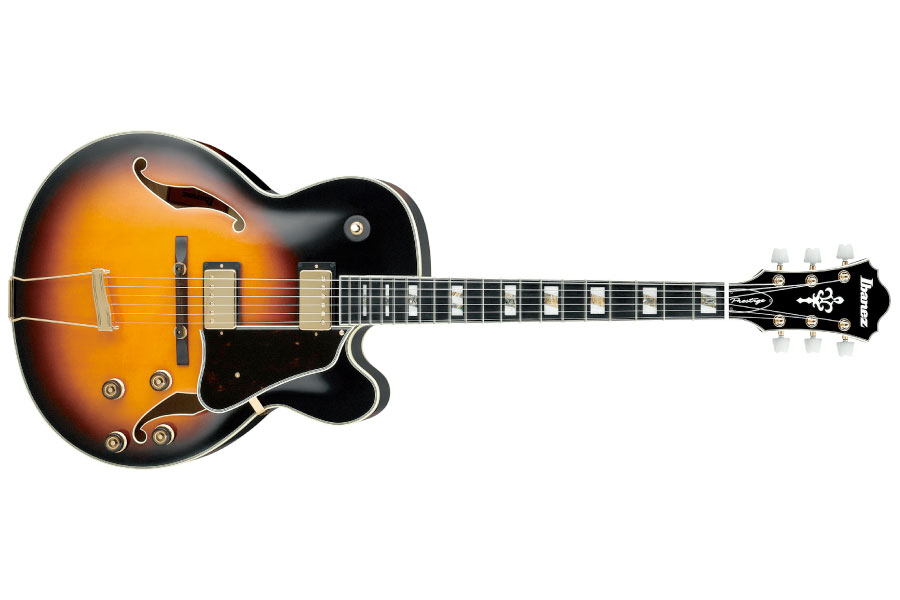
The Ibanez AF200 is released under the Artstar brand, the Japanese company’s top of the range hollow-body guitars. This big jazz-box is clearly influenced by Gibson archtops such as the L5-CES. It’s fitted with Super 58 pickups in both bridge and neck positions and finished in a warm natural sunburst.
- Find out more about the AF200 at Ibanez.
Heritage Eagle Classic
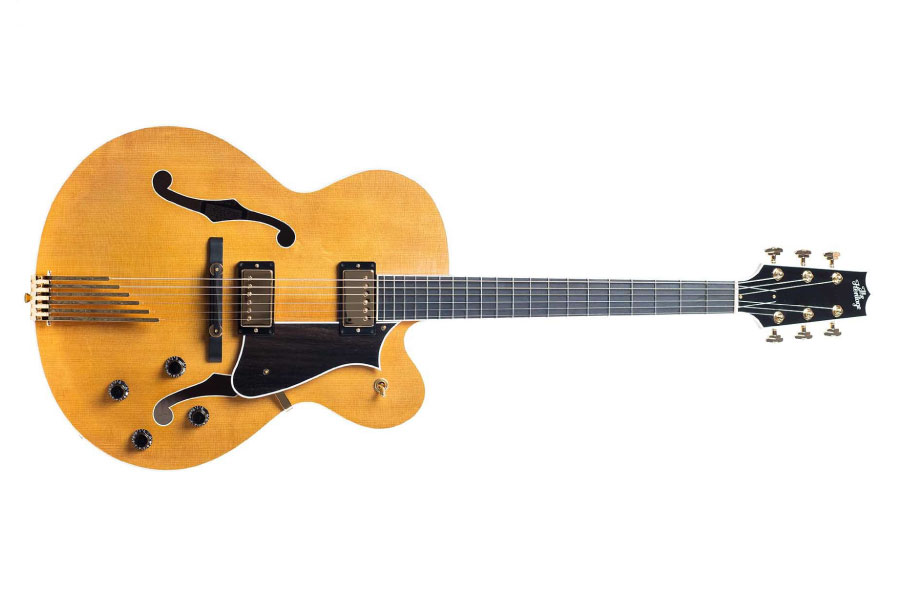
Heritage guitars was formed in 1985 by a group of Gibson employees who weren’t keen on relocating from Gibson’s historic factory in Kalamazoo, Michigan to Nashville.
The Eagle Classic features carved Sitka spruce top and maple back, a rounded cutaway and a nice art-deco-inspired tailpiece.
Also made by the company is the Gibson ES-175-inspired H-575. All Heritage guitars are made at their Michigan factory.
- Find out more about this guitar at Heritage
Gibson ES-175
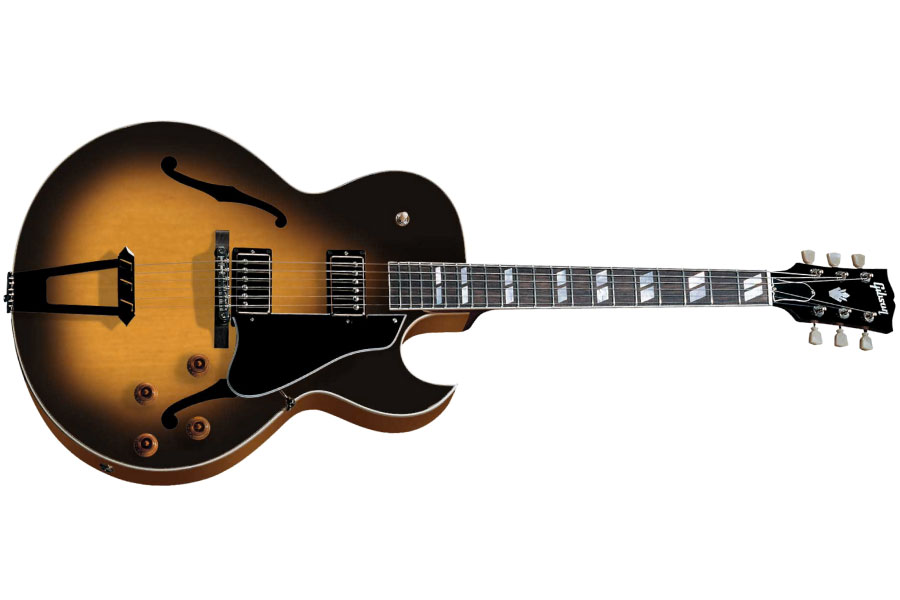
The ES-175 has a pointed single cutaway and either one or two 57 Classic pickups (earlier models were equipped with PAFs). It has been used on countless classic jazz guitar recordings by many of the best-known jazz guitarists, from Joe Pass to Pat Metheny.
Gibson ES-275 Thinline
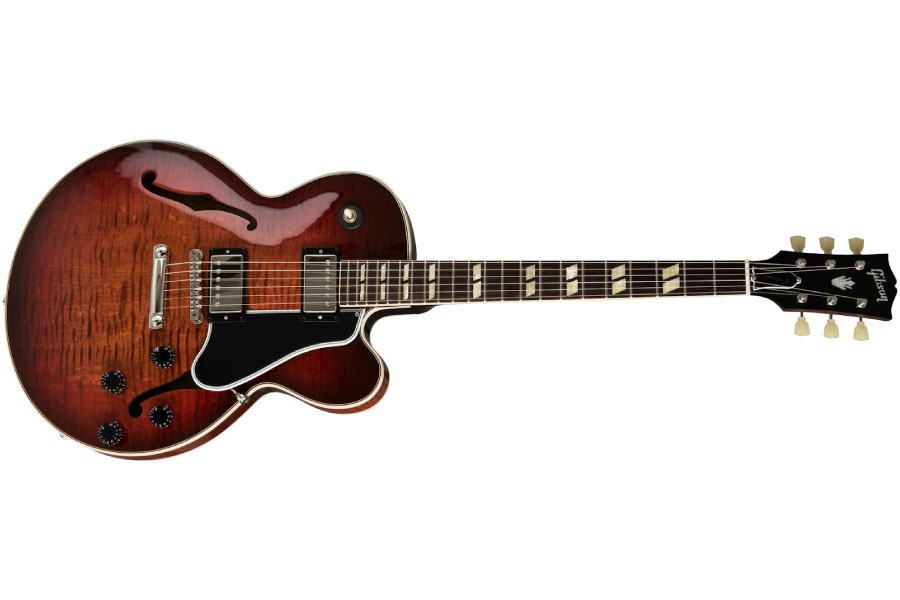
Gibson has currently (mid-2019) stopped production of many of its classic jazz guitars, including the iconic ES-175. The ES-275 is one of the few guitars still made by the company today with any kind of jazz pretentions. It is a thinline, single cutaway archtop guitar finished with beautiful flamed maple.
With a body even thinner than that of an ES-335, and a solid maple center block, you’ll probably be safe from feedback in a standard usual jazz setting.
Not quite a classic jazz guitar, but a beautiful-looking and versatile instrument nonetheless.
- Find out more about the ES-275 at Gibson.
Gibson ES-330
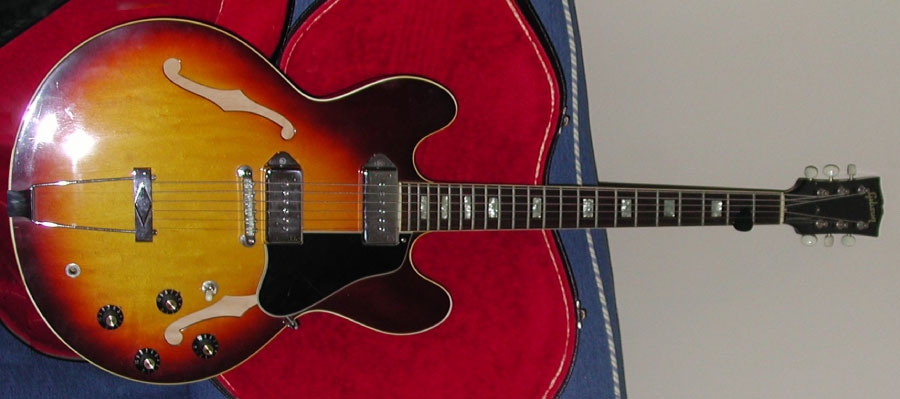
As a result, the ES-330 potentially has more of an archtop sound, at a cost of being more prone to feedback. It is also equipped with two single coil single-coil P-90 pickups, rather than humbuckers.
Gibson ES-335 / Gibson ES-335 Dot
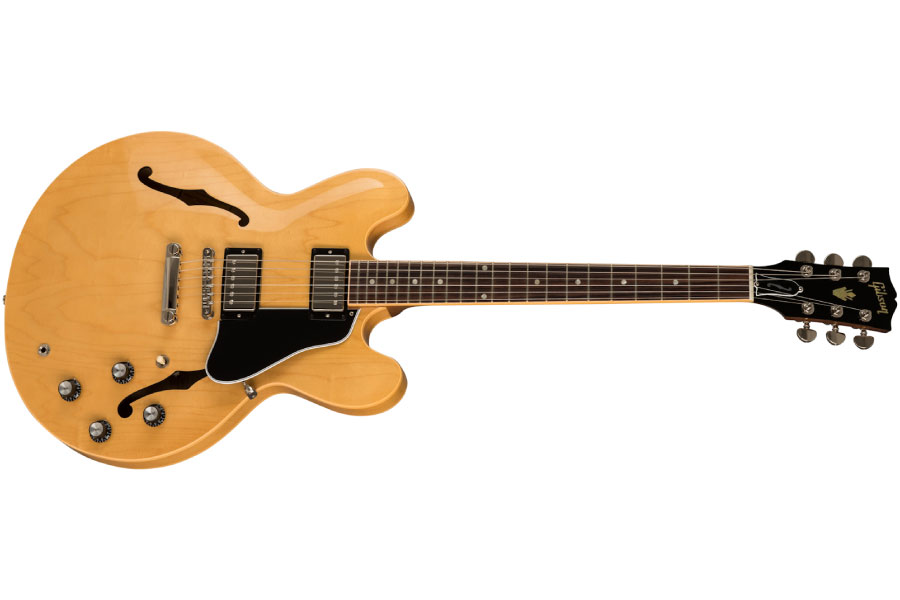
The Gibson ES-335 is a well-known guitar that is used not only in jazz but also in a wide range of other music styles. It has a thinline, archtop body and a feedback-eliminating center block.
Slightly more versatile than a traditional jazz-box, the ES-335 has found favor with a number of contemporary jazz guitarists.
- Find out more about this guitar at Gibson
Gibson ES-5
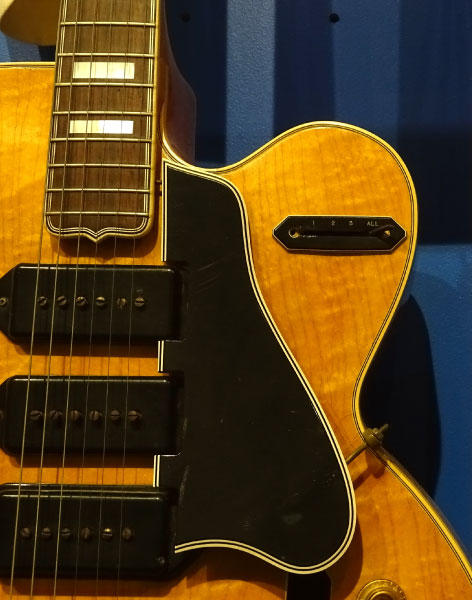
The ES-5 was the first guitar to have three pickups. In the guitar’s first configuration, each pickup had its own volume control. The guitar’s sound was shaped by mixing the balance from each pickup, with a single master tone control giving further tonal choice.
A later model, known as a Switchmaster, introduced a volume and a tone control for each pickup, with a selector switch for choosing between pickup configurations.
D’Angelico Excel
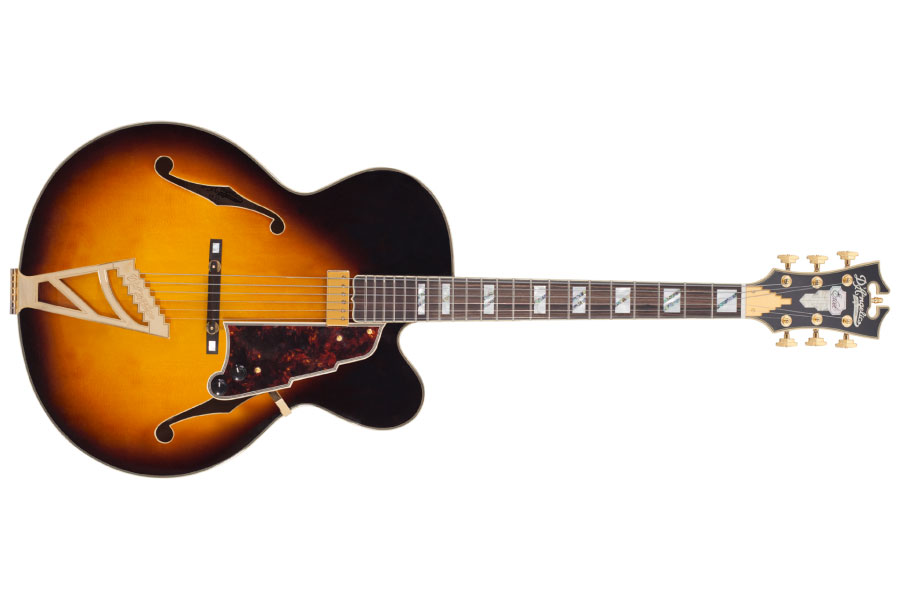
New York guitar maker John D'Angelico worked out of a small workshop in the ‘Little Italy’ area of New York from the 1930’s to the 1960’s. The company became known for the high quality of its archtops, which were used by many notable guitarists of the time.
Two of D’Angelico’s best known models were the Excel and the New Yorker. Both went through numerous iterations, with cutaway and pickup versions being added after the release of the originals.
The art-deco details and fine workmanship make the original D’Angelico guitars highly sought-after.
Rights to the D’Angelico name were acquired by another company, who re-launched the brand in 2011. Today D’Angelico produce a small range of quality acoustic and archtop guitars. The D’Angelico Excel EXL-1, inspired by the original Excel, is one of the best-looking jazz guitars available today.
- Find out more about the Excel EXL-1 at D'Angelico
Ibanez GB10 George Benson
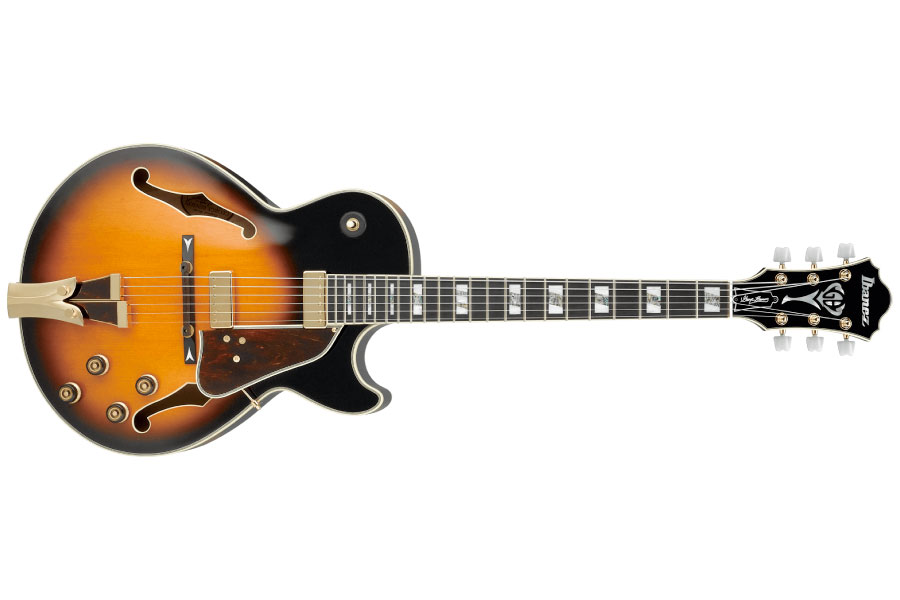
Ibanez’s GB10 George Benson signature model is the company’s longest-running signature model. The guitar has a smaller body than many jazz boxes. This, together with pickups that are mounted off of the body and a thick spruce top help to prevent feedback.
- Find out more at Ibanez
Ibanez JSM100 John Scofield
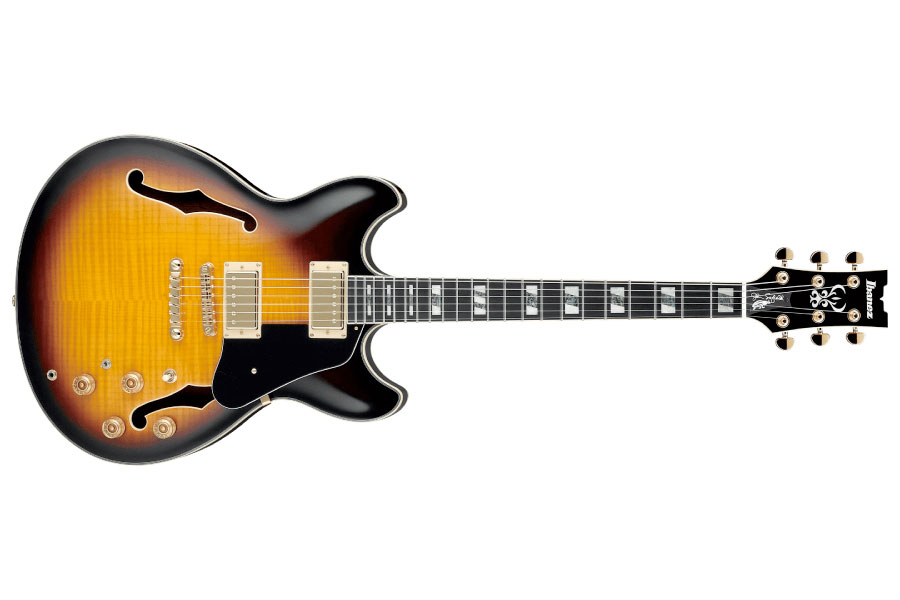
John Scofield is one of the world’s best-known jazz guitarists and has worked with numerous other luminaries, including Miles Davis and Charles Mingus.
His signature model guitar, produced by Ibanez, is based on their own Ibanez AS200. It features a thinline, two cutaway design and comes equipped with two Super 58 pickups. A maple center block helps to reduce the likelihood of feedback.
- Find out more about this guitar at Ibanez
Gibson L-4 CES

The L-4 CES was re-introduced in the 80’s, but is no longer manufactured. As with all Gibson archtops, it is highly collectible and prices reflect that, especially for vintage instruments.
Gibson L-5 CES
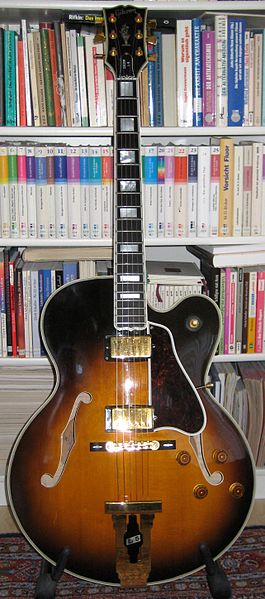
Since its introduction, the L-5 has been at or near the top of Gibson’s archtop range. It is one of the best-known jazz guitars, and has been used by some of the greatest jazz guitarists, including Wes Montgomery.
Gibson Les Paul
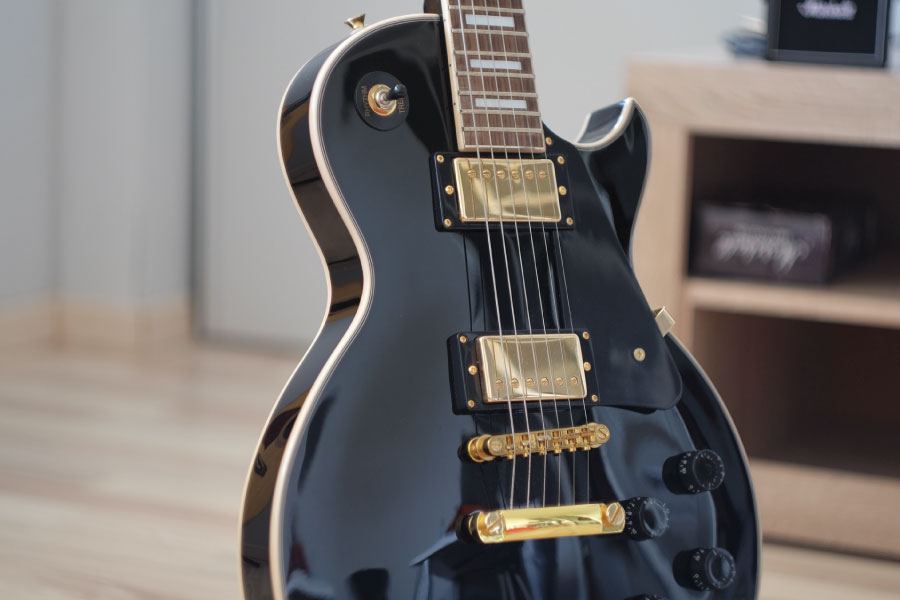
The Gibson Les Paul is one of the first mass-produced electric guitars. It was designed with the aid of jazz guitarist Les Paul, after whom it was named. The distinctive single cutaway, dual humbucker design has been much imitated since the guitar’s introduction in 1952.
Although best known as a hard rock / heavy metal guitar, the Les Paul is capable of producing some sweet jazz tones.
Peerless Maestro Martin Taylor
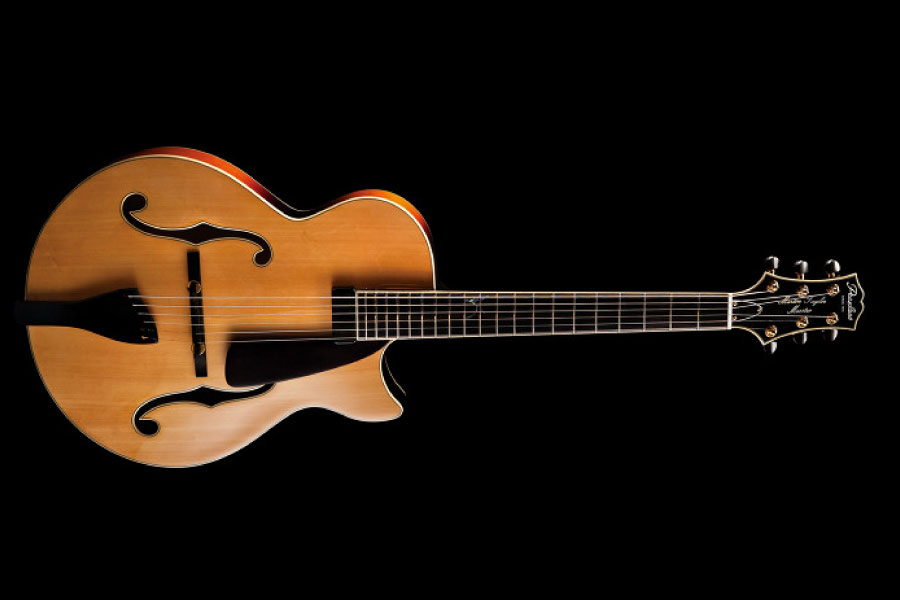
Korean guitar manufacturer Peerless originally made archtop guitars for Ibanez and Epiphone. Today, the company produces high-quality jazz guitars under its own name.
The Maestro is one of two Martin Taylor signature models produced by the company (the other being the cheaper Virtuoso). It features a solid maple top and solid spruce body, and a single mini humbucker for those mellow jazz tones.
- Find out more about this guitar at Peerless.
Benedetto Manhattan
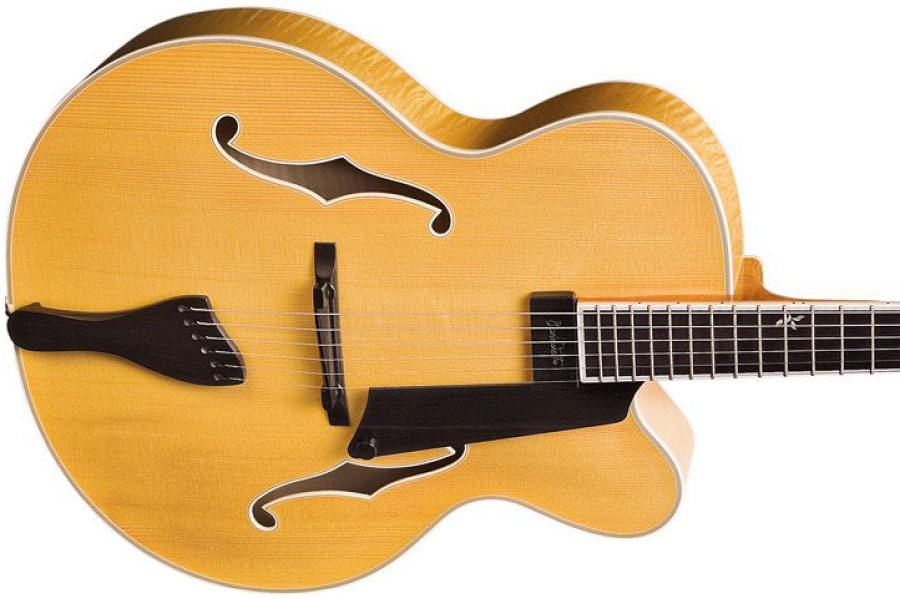
Benedetto, whose guitars are all constructed in the company’s factory in Georgia, USA, produce some of the very best jazz guitars available today.
The Manhattan is the signature model of the Benedetto archtop line, with tonewood selection and quality control being undertaken by Bob Benedetto himself.
The Manhattan features a carved spruce top, a carved maple back and flamed maple sides. It has a 25” scale, ebony fingerboard and 17” lower bout.
Be warned: this beautiful hand-crafted jazz guitar has a correspondingly high price tag.
- Find out more about this guitar at Benedetto.
Selmer / Maccaferri Modèle Jazz

The only purely acoustic guitar in this list of the best jazz guitars is the Selmer / Maccaferri ‘Modèle Jazz’; an instrument made famous by gypsy jazz guitarist Django Reinhardt.
Selmer / Maccaferri guitars were produced from 1932 to around 1952. French instrument manufacturer Selmer enlisted the help of Italian luthier Mario Maccaferri in the design of the guitars.
The original instruments had wide, D-shaped sound holes and were equipped with a resonator to increase the strings’ volume.
Latter models, including the Modèle Jazz, had smaller sound holes and lacked a resonator. These were often used by a band’s lead guitarist, while the older models, which had a less piercing sound, were used by the rhythm guitarist.
Godin Montreal Premiere
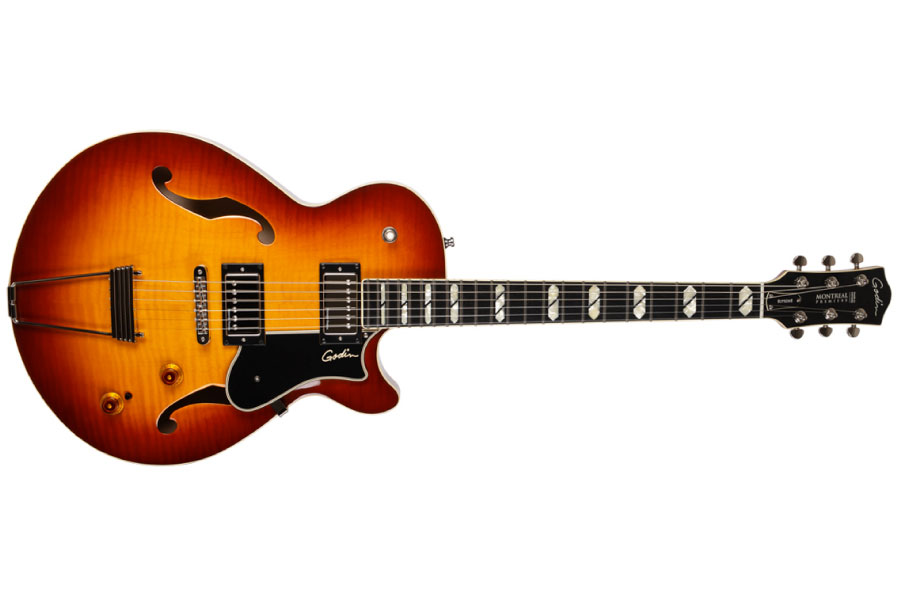
Godin’s Montreal Premier mixes traditional archtop styling with the versatility of a Gibson 335. It has a typical single cutaway shape but with a thinline body with center block. The center block in the case of this guitar is Godin’s ‘breathe through’ design which minimizes contact with the back of the guitar.
Relatively inexpensive when compared to some of the jazz guitars on this list, the Godin may be a good choice if you want to try something a little different.
- Find out more about this guitar at Godin.
Yamaha SA2200
The Yamaha SA2200 is the Japanese company’s take on the Gibson ES-335. Its top, back and sides are made from laminates, and it has a mahogany neck and 24.73 in (628 mm) scale. Users of the SA2200 include John Scofield and Bireli Lagrene.
Gibson Super 400

The Gibson Super 400 is one of the best-known and most influential jazz guitars. This large archtop began life as a variation on the company’s L-5 guitar. It was released in 1934 as an all acoustic guitar without a cutaway. Over time the body style underwent slight changes and a cutaway was eventually added.
During the 1950’s Gibson launched the Super 400 CES, an electric version of the original Super 400. Early models were fitted with P-90 pickups. These were later replaced with Alnico Vs, then, in 1957, with humbuckers.
The ‘400’ in the guitar’s name reflects the instrument’s original $400 price. Today, vintage Super 400’s regularly change hands for tens of thousands of dollars!
Fender Telecaster

The Fender Telecaster is without doubt the solid-bodied guitar most often used in jazz. The guitar’s simple design features a bolt-on neck, strings that are threaded through the body and over a non-tremolo bridge, and two single-coli pickups.
The Telecaster is known for its crystal-clear sound, and with some of its ‘twanginess’ dialed back can be used to create jazz tones with a bit of presence. Jazz guitarists who use Telecasters include Ted Greene, Ed Bickert and Mike Stern.
Guild X-175 Manhattan
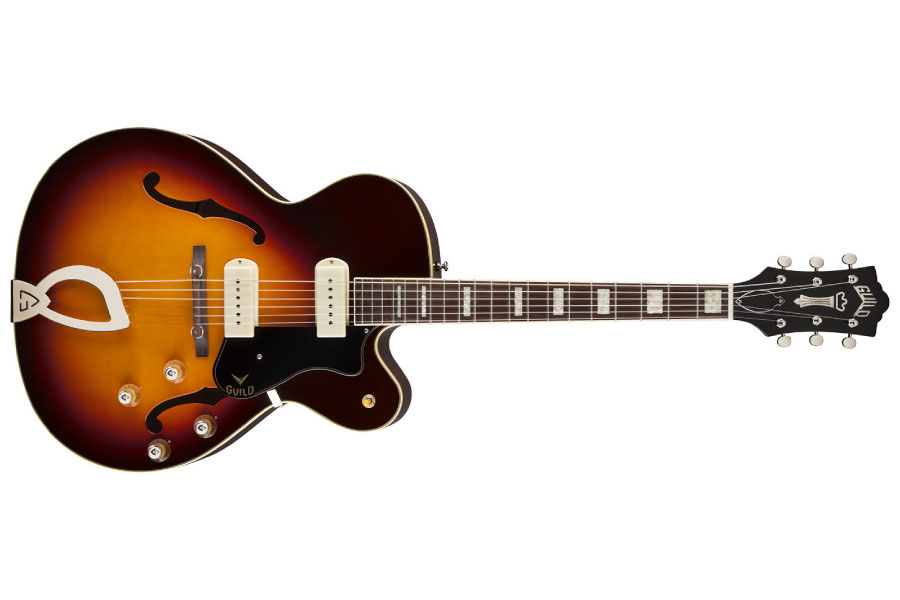
The Guild X-175 Manhattan is a traditional jazz-box produced during the 1950’s and 60’s. It was fitted with two P-90 pickups. The guitar has since been re-released by the now Fender-owned Guild brand.
- You can find out more about this guitar at Guild.
The Best Jazz Guitars: Conclusion
We hope that you’ve enjoyed our look at some of the greatest jazz guitars. At the end of the day it doesn’t matter what type of guitar you have; you can play jazz on any style of instrument. Although archtop guitars are seen as being the definitive jazz guitars, one only has to look at the large numbers of jazz and fusion guitarists now using solid-bodied guitars to see that this view no longer applies.
More Jazz Guitar Articles On Guitar Command
Want some inspiration? Looking to get started playing jazz? Want to learn some new tricks? Check out the following articles…

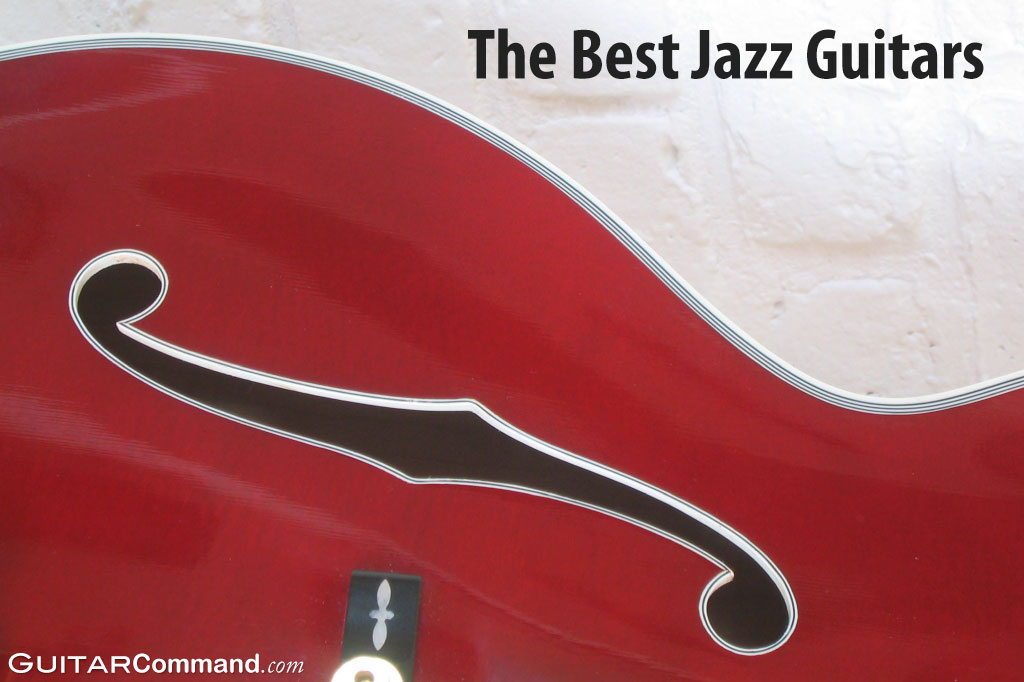

Great list the Ibanez JSM 100 was in a good place on the list, it could have been in the spot of the D’Angelico not because I own one. But a great jazz guitar.
Hi, thank you for your comment.
Yes, both the Ibanez JSM 100 and the AS200 are fantastic guitars. Ibanez have made some great jazz-oriented guitars over the years.
I own an 80’s Ibanez 175 copy which is another great guitar; it’s (probably) as good as–and way cheaper than–the original.
Regards,
The Guitar Command Team